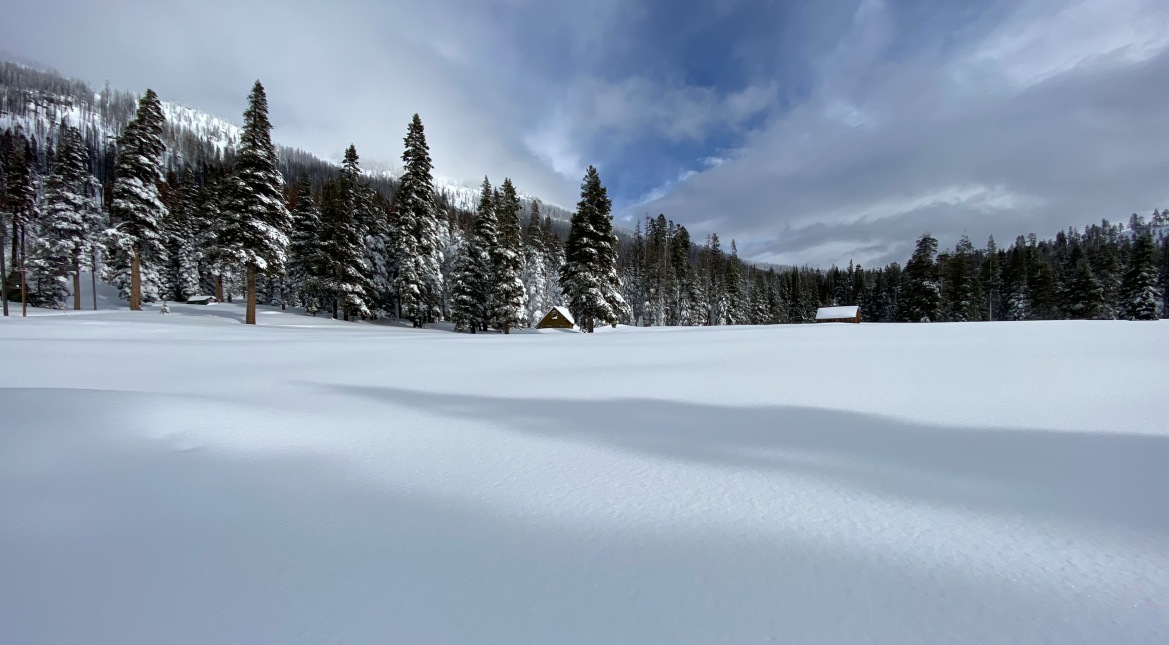Drought Relief Will Depend on Remaining Wet Season
From the Department of Water Resources:
 The Department of Water Resources (DWR) today conducted the first snow survey of the season at Phillips Station. Early winter storms this month provided a strong start to the season and some drought relief, but California remains in a drought.
The Department of Water Resources (DWR) today conducted the first snow survey of the season at Phillips Station. Early winter storms this month provided a strong start to the season and some drought relief, but California remains in a drought.Today’s manual survey recorded 78.5 inches of snow depth and a snow water equivalent of 20 inches, which is 202 percent of average for this location on this date. The snow water equivalent measures the amount of water contained in the snowpack and is a key component of DWR’s water supply forecast. Statewide the snowpack is 160 percent of average for this date.
“We could not have asked for a better December in terms of Sierra snow and rain,” said DWR Director Karla Nemeth. “But Californians need to be aware that even these big storms may not refill our major reservoirs during the next few months. We need more storms and average temperatures this winter and spring, and we can’t be sure it’s coming. So, it’s important that we continue to do our part to keep conserving – we will need that water this summer.”
Californians only need to look to last winter and the state’s disappointing snowpack runoff due to high temperatures, dry soil and evaporation as a reminder that changes to our climate mean it will take more than an average year to recover from drought.
 “California continues to experience evidence of climate change with bigger swings between wet and dry years and even extreme variability within a season. A wet start to the year doesn’t mean this year will end up above average once it’s all said and done,” said Sean de Guzman, Manager of DWR’s Snow Surveys and Water Supply Forecasting Unit.
“California continues to experience evidence of climate change with bigger swings between wet and dry years and even extreme variability within a season. A wet start to the year doesn’t mean this year will end up above average once it’s all said and done,” said Sean de Guzman, Manager of DWR’s Snow Surveys and Water Supply Forecasting Unit.December is the first of the three typically wettest months of California’s water year. Significant January and February precipitation would be required to generate enough runoff to make up for the previous two winters that were California’s fifth- and second-driest water years on record.
California has experienced wet Decembers before only to have storms disappear for the remainder of the season. In 2013, the first snow survey provided promising results after a wet December, similar to this year. However, the following January and February were exceptionally dry, and the year ended as the driest on record, contributing to a record-breaking drought.
On average, the Sierra snowpack supplies about 30 percent of California’s water needs and the snowpack is an important factor in determining how DWR manages the state’s water resources. Its natural ability to store water is why the Sierra snowpack is often referred to as California’s “frozen reservoir.”
As spring sets in, the snowpack begins to melt. Water that is not absorbed into the ground, called “runoff,” trickles into mountain streams, which feed rivers and eventually aqueducts and reservoirs, where it can be stored for use throughout the dry season. Climate change is affecting California’s snowpack, as more precipitation falls as rain and less as snow. Excessively dry soils and dry, warm spring temperatures are also reducing yearly runoff.
Due to these climate-induced changes, DWR is investing in partnerships and implementing emerging and proven technologies to improve forecasts of precipitation, seasonal snowpack, and runoff to support more efficient water management now and to help estimate the impacts of climate change on future flood and drought conditions. Forecast improvements and monitoring enhancements increase the reliability of data used to inform water managers about flood risks, allowing opportunities to create more storage in reservoirs ahead of big storms while also ensuring water supply reliability in periods of dry or drought conditions.
DWR conducts five media-oriented snow surveys at Phillips Station each winter near the first of each month from January through April and, if necessary, May.



